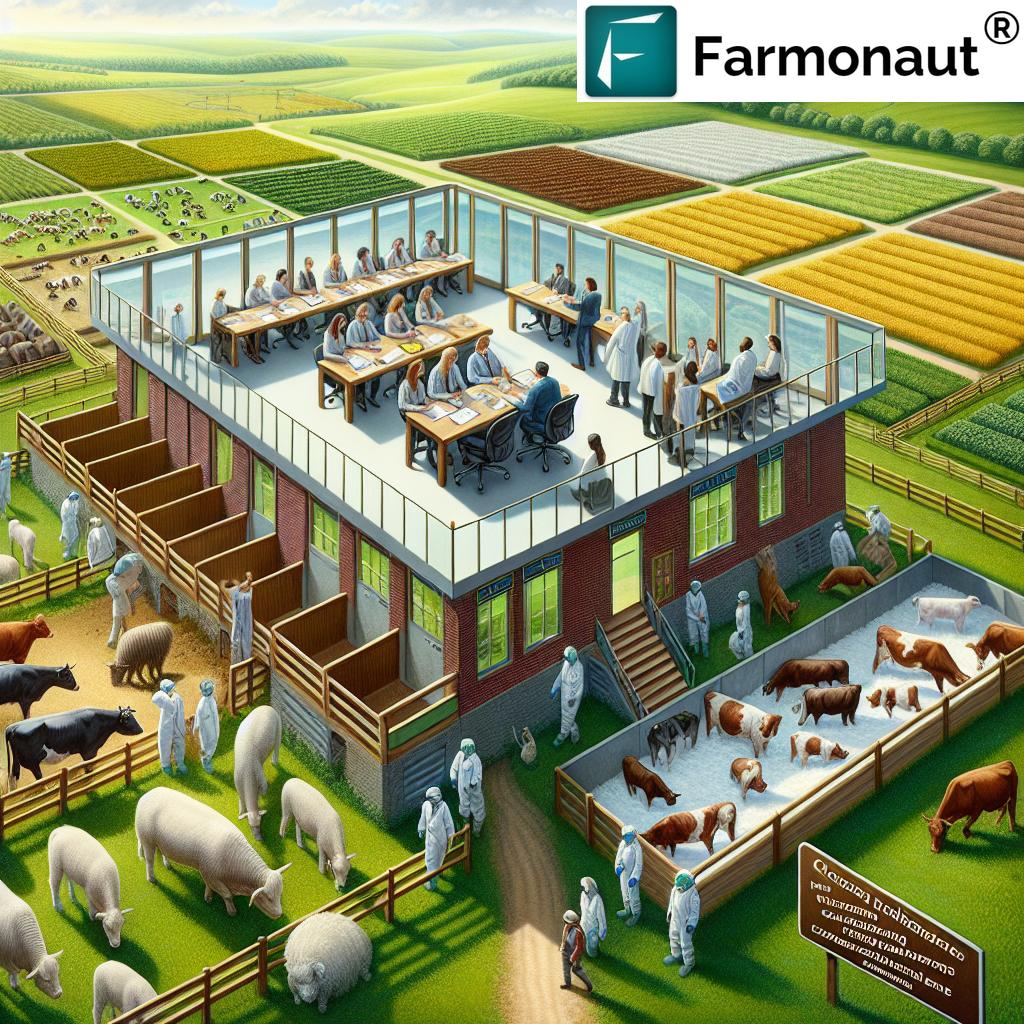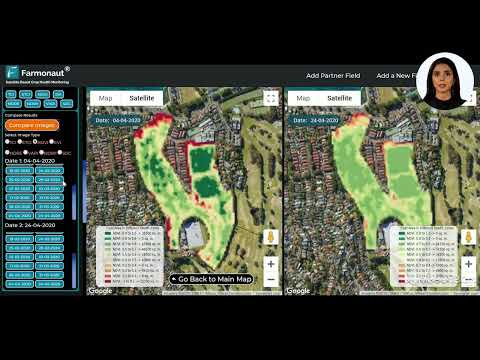Essential Veterinary Care for Farm Animals: Maintaining Health and Welfare During the Pandemic

“During the pandemic, veterinary medicine regulations were eased, affecting access for over 1 million US farmers.”
As we navigate the challenges posed by the COVID-19 pandemic, maintaining animal health and welfare has become more crucial than ever. In this comprehensive guide, we’ll explore essential guidelines for livestock care during the pandemic and how to ensure continuity of veterinary services for farms while adhering to social distancing in agriculture. Our team at Farmonaut recognizes the importance of adapting to these unprecedented times, and we’re here to provide you with expert insights on managing your farm animals’ health effectively.
The Impact of COVID-19 on Farm Animal Care
The pandemic has brought about significant changes in how we approach animal care on farms. Here are some key areas affected:
- Reduced frequency of routine veterinary visits
- Challenges in maintaining regular health check-ups
- Difficulties in accessing veterinary medicines
- Increased focus on farm biosecurity measures
- Adaptation of farm hygiene practices to prevent virus spread
Despite these challenges, it’s crucial to ensure that essential agricultural services continue to operate while prioritizing the safety of both farm workers and animals.
Implementing Effective Farm Hygiene Practices
Maintaining proper hygiene on farms is more important than ever. Here are some essential practices to implement:
- Regular handwashing: Ensure all farm workers wash their hands frequently with soap and water for at least 20 seconds.
- Sanitization stations: Set up sanitization points throughout the farm for easy access.
- Personal Protective Equipment (PPE): Provide appropriate PPE for workers, including masks and gloves.
- Cleaning and disinfection: Increase the frequency of cleaning and disinfecting common areas and equipment.
- Visitor restrictions: Limit non-essential visitors to the farm to reduce potential exposure.
Implementing these farm hygiene practices can significantly reduce the risk of disease transmission among both humans and animals.
Adapting Veterinary Services for Farms
Veterinary professionals have had to adapt their services to ensure continuity of care while minimizing physical contact. Here are some ways veterinary services for farms have evolved:
- Telemedicine consultations for non-emergency cases
- Prioritization of urgent and emergency cases for in-person visits
- Implementation of strict biosecurity protocols for on-farm visits
- Use of video calls for remote diagnosis and advice
- Contactless medicine delivery services
These adaptations help maintain essential animal care while reducing the risk of virus transmission.
Animal Care Guidelines During the Pandemic
To ensure optimal animal health and welfare during these challenging times, we recommend following these guidelines:
- Regular health monitoring: Conduct daily health checks on your livestock, looking for any signs of illness or distress.
- Maintain vaccination schedules: Keep up with essential vaccinations to prevent outbreaks of preventable diseases.
- Nutrition and hydration: Ensure animals have access to clean water and appropriate feed at all times.
- Exercise and enrichment: Provide opportunities for natural behaviors and exercise to maintain physical and mental well-being.
- Stress reduction: Minimize stressors in the animal’s environment, as stress can impact immune function.
By following these animal care guidelines, farmers can help maintain the health and welfare of their livestock during the pandemic.
Changes in Veterinary Medicine Regulations
In response to the pandemic, many countries have implemented changes to veterinary medicine regulations to ensure continued access to essential medications. Some key changes include:
- Relaxed restrictions on telemedicine for veterinary consultations
- Extended prescription validity periods for certain medications
- Allowance for remote prescribing in certain circumstances
- Increased flexibility in medicine supply chains
These regulatory changes aim to facilitate continued access to necessary veterinary care while minimizing physical contact.
Managing Farm Operational Challenges
The pandemic has presented numerous farm operational challenges that require innovative solutions. Here are some strategies to address these challenges:
- Workforce management: Implement shift systems to reduce the number of workers present at any given time.
- Supply chain adaptations: Diversify suppliers and consider local sourcing options to ensure consistent access to essential supplies.
- Technology adoption: Utilize farm management software and remote monitoring tools to streamline operations.
- Financial planning: Develop contingency plans and explore available support programs to manage financial uncertainties.
- Communication strategies: Establish clear communication channels with employees, suppliers, and customers to address concerns and share updates.
By addressing these operational challenges, farmers can maintain productivity while ensuring the safety of their workforce and animals.
“Implementing proper handwashing protocols on farms can reduce disease transmission by up to 50% among livestock.”
Livestock Health Management During the Pandemic
Livestock health management has become more complex during the pandemic. Here are some key considerations:
- Enhanced biosecurity: Implement stricter biosecurity measures to prevent disease introduction and spread.
- Remote monitoring: Utilize technology for remote health monitoring and early detection of issues.
- Stockpiling essentials: Maintain adequate supplies of essential medications and treatments.
- Training and education: Provide additional training to farm staff on health management and disease recognition.
- Contingency planning: Develop plans for managing potential disease outbreaks with limited external support.
These strategies can help maintain optimal health for your livestock even with reduced veterinary access.
Explore Farmonaut’s API for advanced agricultural insights
Social Distancing in Agriculture: Best Practices
Implementing social distancing in agriculture is crucial for protecting both farm workers and animals. Here are some best practices:
- Workspace modifications: Rearrange workspaces to ensure adequate distance between workers.
- Staggered schedules: Implement staggered work shifts and break times to reduce worker density.
- Virtual meetings: Conduct farm meetings and training sessions virtually when possible.
- Individual equipment: Assign individual tools and equipment to workers to minimize sharing.
- Outdoor activities: Prioritize outdoor work activities where possible, as they pose a lower risk of virus transmission.
These practices help maintain essential farm operations while minimizing the risk of COVID-19 transmission.
Ensuring Continuity of Essential Agricultural Services
Maintaining essential agricultural services is critical for food security and animal welfare. Here’s how to ensure continuity:
- Prioritize critical services: Identify and prioritize essential services that must continue uninterrupted.
- Cross-training: Train staff in multiple roles to ensure coverage in case of illness or quarantine.
- Remote services: Utilize remote services where possible, such as virtual consultations with veterinarians.
- Emergency protocols: Develop clear protocols for managing emergencies while maintaining safety measures.
- Collaboration: Work with local authorities and agricultural organizations to ensure support for essential services.
By focusing on these areas, farms can maintain critical operations while adapting to pandemic-related challenges.
Access Farmonaut’s API Developer Docs for integration guidance
Comparative Analysis of Essential Veterinary Care Practices
| Animal Type | Pre-Pandemic Care Practices | Pandemic-Era Care Practices | Key Challenges | Recommended Solutions |
|---|---|---|---|---|
| Dairy Cows | Regular on-site vet checks | Telemedicine consultations; reduced on-site visits | Maintaining udder health; early mastitis detection | Implement remote monitoring systems; train staff in basic health checks |
| Goats | Monthly herd health assessments | Quarterly assessments; increased farmer-led monitoring | Parasite control; nutritional management | Provide farmers with diagnostic tools; schedule virtual nutrition consultations |
| Poultry | Weekly flock inspections | Bi-weekly inspections; enhanced biosecurity measures | Disease outbreak prevention; ventilation management | Install automated monitoring systems; implement strict visitor protocols |
| Sheep | Seasonal health checks and shearing | Essential-only handling; delayed non-critical procedures | Lambing assistance; wool management | Train farmers in basic obstetrics; develop socially-distanced shearing methods |
| Pigs | Regular vaccinations and growth monitoring | Extended vaccination schedules; remote growth tracking | Maintaining biosecurity; stress management | Implement contactless feed delivery; provide environmental enrichment |
Adapting to Policy Changes and Enforcement Guidelines
Staying informed about policy changes and enforcement guidelines is crucial for farmers during these times. Here’s what you need to know:
- Regulatory updates: Keep abreast of changes in agricultural and veterinary regulations.
- Compliance measures: Implement new compliance measures as required by local and national authorities.
- Documentation: Maintain thorough records of health practices and any pandemic-related adaptations.
- Industry guidelines: Follow industry-specific guidelines for pandemic management in agriculture.
- Government support: Stay informed about available government support programs for farmers.
By staying informed and adaptable, farmers can navigate the evolving regulatory landscape effectively.
Managing Specific Livestock Sectors During the Pandemic
Different livestock sectors face unique challenges during the pandemic. Here’s a breakdown of key considerations for specific sectors:
Dairy Farms
- Implement contactless milk collection procedures
- Enhance udder hygiene practices to prevent mastitis
- Adjust milking schedules to accommodate social distancing measures
- Maintain strict hygiene in milking parlors
Goat Herds
- Focus on parasite control with reduced veterinary access
- Implement remote monitoring for kidding season
- Adjust feeding practices to maintain optimal nutrition
- Enhance biosecurity measures for visiting buck services
Poultry Farms
- Increase automation in feeding and egg collection
- Implement stricter biosecurity measures for essential visitors
- Enhance ventilation systems to improve air quality
- Develop contingency plans for potential supply chain disruptions
By addressing sector-specific challenges, farmers can maintain productivity and animal welfare despite pandemic-related obstacles.
Leveraging Technology for Farm Management
Technology plays a crucial role in adapting to pandemic-related challenges. Here’s how farmers can leverage technology:
- Remote monitoring systems: Implement sensors and cameras for real-time animal health monitoring.
- Farm management software: Utilize digital tools for record-keeping and operational planning.
- Telemedicine platforms: Adopt veterinary telemedicine solutions for remote consultations.
- Automated feeding systems: Reduce human contact through automated feeding technologies.
- Drone technology: Use drones for field inspections and livestock monitoring.
At Farmonaut, we offer advanced satellite-based farm management solutions that can significantly enhance your farm’s efficiency and productivity during these challenging times.
Maintaining Mental Health and Well-being on the Farm
The pandemic has brought additional stress to farming communities. Here are some strategies to maintain mental health:
- Stay connected: Maintain social connections through virtual means.
- Seek support: Utilize mental health resources available for farmers.
- Establish routines: Maintain regular schedules to provide structure and stability.
- Practice self-care: Prioritize sleep, nutrition, and exercise.
- Set realistic goals: Adjust expectations to match the current situation.
Remember, taking care of your mental health is crucial for effectively managing your farm and animals during these challenging times.
Future Outlook: Preparing for Post-Pandemic Agriculture
As we look towards the future, it’s important to consider how the agricultural sector might evolve post-pandemic:
- Increased adoption of technology: Expect continued growth in farm automation and digital solutions.
- Enhanced biosecurity measures: Many pandemic-era hygiene practices may become standard.
- Resilient supply chains: Expect a focus on developing more robust and flexible agricultural supply chains.
- Emphasis on local production: There may be increased support for local and regional food systems.
- Continued telemedicine integration: Remote veterinary services are likely to remain a key part of animal healthcare.
By anticipating these trends, farmers can position themselves for success in the post-pandemic agricultural landscape.
Conclusion
Maintaining animal health and welfare during the COVID-19 pandemic presents unique challenges, but with the right strategies and adaptations, farmers can continue to provide essential care for their livestock. By implementing robust hygiene practices, leveraging technology, and staying informed about regulatory changes, the agricultural sector can navigate these unprecedented times effectively.
Remember, the key to success lies in flexibility, innovation, and a commitment to both human and animal welfare. As we continue to adapt to the new normal, the resilience and ingenuity of the farming community will undoubtedly shine through, ensuring the continued health and productivity of our farms and animals.
At Farmonaut, we’re committed to supporting farmers through these challenging times with our advanced agricultural technology solutions. Together, we can overcome the obstacles posed by the pandemic and emerge stronger, more efficient, and better prepared for the future of farming.
FAQ Section
Q: How has the pandemic affected veterinary care for farm animals?
A: The pandemic has led to reduced on-site veterinary visits, increased use of telemedicine, and adaptations in health management practices to maintain animal welfare while minimizing human contact.
Q: What are the key hygiene practices farmers should implement during the pandemic?
A: Essential hygiene practices include frequent handwashing, use of PPE, increased cleaning and disinfection of facilities, and limiting farm visitors to reduce potential exposure.
Q: How can farmers ensure continuity of essential veterinary services during lockdowns?
A: Farmers can utilize telemedicine services, prioritize urgent cases for in-person visits, and work closely with veterinarians to develop emergency protocols that adhere to safety guidelines.
Q: What technological solutions can help in managing farm animals during the pandemic?
A: Remote monitoring systems, farm management software, telemedicine platforms, and automated feeding systems can all contribute to effective farm management while reducing human contact.
Q: How can farmers stay updated on policy changes affecting animal health and welfare?
A: Farmers should regularly check updates from local agricultural departments, veterinary associations, and industry organizations. Subscribing to relevant newsletters and participating in virtual industry events can also help stay informed.







